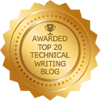What is writing strategy?
“If you fail to plan, you are planning to fail,” Benjamin Franklin famously said.
Writers would be wise to take those words to heart. That’s because most would-be writers approach their work with a simple strategy in mind: none. They make no plans and have no strategy at all. Instead, most skip the planning/pre-writing stage and fall immediately into a massive trap: the “First Draft Equals Final Draft” Mistake. In this “strategy,” writers simply dive right into writing. They are just “putting words on the page and hoping for the best.” They have no real strategy, except to write and write and write, while thinking that what they’re writing will be the final draft—that all they’ll have to do is to correct some grammar and punctuation errors, change passive voice to active, tidy it up a bit, and the document will be ready to submit.
Writing strategy is an action plan to produce high quality documents, but it requires thinking critically about the document and what the writer is trying to achieve. It’s a way to connect the dots between what the writer wants to say and meeting the readers’ needs or achieving a particular goal.
Fundamentally, writing strategy requires actual planning – which we also call “pre-writing” – that you should do before you start work on the actual sentence-by-sentence draft of a document. Here, writers have plentiful options. Any one or more of the following pre-writing activities can power up a writing strategy to produce excellent content.

-
Audience analysis
Foundational to any writing strategy is understanding who will be reading your words. Specifically, effective writers consider their audience, what their audience needs from the document, and how the audience is going to use the document.
First, we can consider many aspects when considering our audience:
Beyond these considerations, however, we might also assess factors like:
- Their knowledge of the topic,
- Their educational background; their age, gender, or race,
- Their role within an organization (are they a decision-maker, for instance?), and even
- Their demographics.
Beyond these considerations, however, we might also assess factors like:
- Their tolerance for the message (is the news good or bad?),
- Their tolerance for the writer and/or the organization for which the writer works (has the reader had a bad experience with the organization and/or with the writer?), and even
- How busy the reader may be.
Knowing, for instance, that a reader is busy can help writers organize so that the most important, or relevant, information is first rather than last. A busy reader, for instance, probably also wants headings and/or subheadings in the document, so that they can easily skim the document and/or find the information of most interest quickly.
-
Modeling
Modeling is the ultimate pre-writing activity; it essentially means re-using drafted content. Writers “model” when they use a past report or document that either they or someone else wrote. This is different from using a template, which is a conventional format for a particular kind of document and simply serves as the foundation for content.
Yes, re-using content over and over can dramatically shorten writing times. However, be cautious with it. The problem with modeling is that it assumes the “model” was successful (not always true) or that it will continue to be successful, even in a new situation with new readers. The truth is, every document should be written for a specific audience and a specific purpose, so modeling’s “one-size-fits-all” approach is unlikely to be effective. This is a pre-writing activity to use sparingly.
-
Freewriting
Freewriting is like a “brain dump” that can help writers get over writer’s block. It’s also very straightforward: to freewrite, you just write. You don’t worry about grammar or punctuation or even content. Don’t try to control the writing, but rather let the ideas flow as they will.
Freewriting is like stretching before a workout, and it’s a good way to ease into the physical act of writing (which, for some writers, is itself a big obstacle to writing). It can also strengthen writing skills overall; a study from the University of Hawaii found that after eight weeks of freewriting, students’ overall writing fluency showed statistically significant improvement.
Freewriting can produce brilliant ideas or garbage, but what it produces doesn’t matter because, again, the idea is just to get into the physical and mental act of writing. Your freewritten material isn’t a draft so much as a way to prepare yourself for drafting. At best, it may yield a lump of clay that you can later shape through editing, revisions, and further writing.
-
Brainstorming
Brainstorming is another great strategy. Unlike freewriting, in which the writer writes prose (sentences), in brainstorming the writer is listing ideas as quickly as they form, again without passing judgment on them. Sentence fragments, even single words, are fine. So are lines and arrows and even drawings, if they help suggest an idea or connect multiple ideas together, like a “mind map.”
-
Outlining
A robust outline can help you organize your ideas, but keep in mind that outlines don’t work for everyone and aren’t a must.
The theory behind outlines is that they help the writer organize the document and keep the writer on track. The problem with outlines, however, is that, before creating an outline, the writer has to have a clear idea of what she wants to say in the document. In other words, to organize ideas, the writer has to first have generated ideas, and outlines may not be the best method to generate ideas. Think of outlining as one tool in the toolbox, appropriate for some writing needs and not for others.

Ultimately, pre-writing activities can save time, reduce stress, and produce more impactful documents.
Pre-writing creates a strong foundation for the draft and helps a writer more clearly see the shape and content of the final document. After pre-writing, a writer can more easily pick out ideas and see how they’ll fit together, rather than beginning a draft based on a faulty premise or a weak idea and realizing the mistake only after wasting a great deal of time and effort. In the end, starting with these pre-writing activities means creating a plan to succeed, and in the end, that’s the best writing strategy of all.
Ready to power up your team’s writing strategy?
Help your team write more effective documents in less time!
See Course Details

